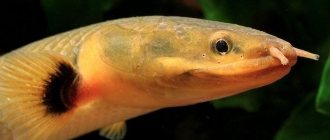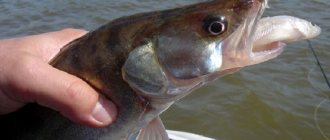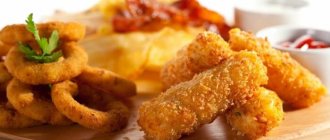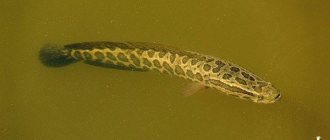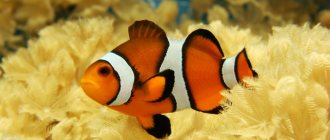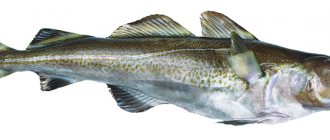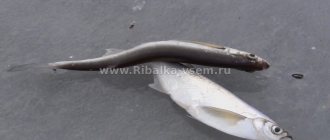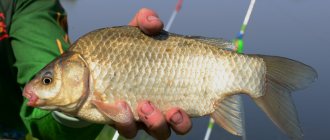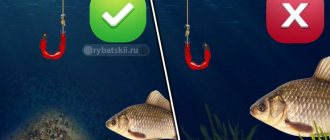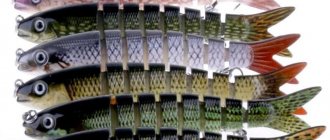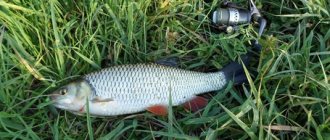The snakehead is a popular aquarium inhabitant among exotic lovers. Freshwater fish of the snakehead family (Channidae). Externally, the fish resembles a snake and is distinguished by aggressive behavior, but this is only one side of the coin. Beautiful and large snakeheads have special habits; it is always interesting to watch them. Some fish grow too large to be kept at home, while others are quite accessible to experienced aquarists.
Aquarium snakehead fish
Living in the wild
Due to the diversity species , we can talk about the diversity of their habitat. Some species live in subtropical waters (Iran, China, Afghanistan, etc.), others are found in equatorial zones (India, Africa). Some snakeheads were able to take root in southern Siberia and the USA. Fish for aquarium keeping are exported mainly from India, Southeast Asia, and Congo.
Snakehead
Appearance of a snakehead
The fish has a thin, elongated body, the head is similar in color and shape to a snake (as if covered with small scales). Depending on the species, the appearance of the snakehead may differ: some have a more elongated snout, others do not have an anal fin , and others are especially long when compared with their counterparts.
The body color of a snakehead can vary
Note ! Body color also depends on the species, but in general terms it looks like this: thin small patterns on a contrasting background.
Snakeheads for the aquarium
Video – Channa marulioides
Popular species of snakehead
Let's consider which species of snakehead are especially popular among lovers of aquarium exotics.
Table. Common species of snakehead.
| Name, photo | Short description |
| It is the largest representative - its body length can reach 60 cm. The imperial snakehead does not tolerate neighbors. The body is light below, dark above; the transition between colors is clear and contrasting. Red eyes. Due to its large size, it is rarely found in aquariums. |
| A beautiful and large predatory fish with a body compressed from the sides (which makes it look like ordinary fish). Also called the three-spotted snakehead, the ocellated snake gets its title from the large black spots on its side. Body color is gray-silver. The length is about 45 cm, and therefore the fish is kept only in large aquariums. |
| The most popular species of snakehead due to its size (does not grow more than 15 cm). A relatively peaceful fish: it does not bother its relatives, as well as those larger than it. Often kept in a small flock. But during spawning , aggression still manifests itself, so a pair ready for mating must be removed. |
| The most aggressive species towards its neighbors, especially in closed aquarium conditions. Although in the wild, the red snakehead hunts with pleasure and keeps surrounding aquatic organisms , including relatives, at bay. Body length is 15-20 cm. |
| Also an inveterate aggressor. Due to its elongated body and wide-opening lower jaw, it is similar to an arowana. The body length is 15-20 cm. It does not tolerate any neighbors except snakeheads. Needs a spacious aquarium with shaded areas: location of the tank in the shade, plenty of foliage, etc. |
| A shy fish that grows up to 20 cm. The muzzle is more rounded than that of other snakeheads. It is distinguished by a closed lifestyle in the aquarium - it hides in shelters. The color is turquoise, the rays on the fins are shaded. |
| An inhabitant of southern India, growing up to 40 cm. The body color of adult individuals is rich brown, with lighter fins. Suitable for consumption, therefore it is an object of fishing. Also known as the red-banded snakehead (juveniles may have a red stripe along their body). |
| It poses a serious danger to most fish: with a body size of up to 40 cm, this snakehead willingly devours everyone who fits into its huge mouth. He is also very similar to a snake, very resourceful and agile. Body color is a combination of yellow and blue. |
| Grows up to 30 cm. Gets along with its own kind, but is aggressive towards its neighbors. It has a dark blue body color, fins are black and white, contrasting. There are also small oblong spots of golden color scattered across the body. |
Video – Snakehead Channa pulchra
The Asian snakehead has an elongated, almost cylindrical body with long dorsal and anal fins. The head is rounded, serpentine, flat on top. It is covered with large scales similar to the shields of snakes. At the root of the tail there is a black eye spot. The sides of the fish range in color from light brown to olive green. They are also strewn with silver speckles, and a row of dark diamond-shaped marks runs along the back.
The Asian snakehead has a large mouth armed with sharp teeth. Males of the Snakehead are larger than females and more brightly colored. The Asian Snakehead is one of the smallest representatives of the family. In Southeast Asia, the Snakehead reaches a length of more than 30 cm. When kept in an aquarium, the size of an adult specimen is no more than 15-20 cm.
This species has intraspecific aggression, which is directed only at individuals of the same sex. A pair of fish of different sexes lives peacefully. Sexual dimorphism in Asian snakeheads is not pronounced. If you look at an adult male from above, you will notice that his head is slightly wider. But this feature is barely noticeable. Therefore, choosing a pair on your own is very difficult. In this case, you have to give the fish a choice; they will decide for themselves, driving away the unnecessary ones. Channas begin to show aggression when they are 5-6 cm in size. snakeheads do not ruffle each other’s fins and do not lock their mouths. They deliver powerful blows to the side, after which whitish marks and peeling scales remain.
Due to the possibility of atmospheric breathing, snakeheads inhabit various water bodies, including those with poor oxygen conditions. As a rule, these are wetlands of rivers and lakes, rice paddies, and ditches. They are able to tolerate short-term drying out of reservoirs by burying themselves in moist soil. Snakeheads are able to move on land, so if necessary, they prefer to look for a new habitat. Snakeheads sexual maturity at the age of six months. The size of the Asian snakehead reaches 8 cm by 6 months.
Spawning:
in the spawning behavior of the Asian Snakehead that distinguish it from other members of the family. Spawning occurs at temperatures above 25°C. The optimal temperature is 27 °C. Channas are more willing to spawn in a low column of water, about 20 cm. At this time, the aggressiveness of the Asian Snakehead increases. The male hugs the female in a ring, and then collects eggs with his mouth, which float in groups on the surface of the water. It is in the male’s mouth that further development of the eggs continues. At this time, the father often rises for air, and sometimes hangs near the surface and ventilates the eggs. After 72 hours, the larvae hatch from them. After 7-8 days, the male begins to release the fry. At this age, the fry can already feed on their own, but since the “labyrinth” has not yet been formed, they breathe through gills. The female does not take part in bearing the fry, but stays nearby. She helps protect them. To shelter the fry from danger, parents dig a small hole in the ground or use natural shelters.
Having reached a size of 1.5 cm, the fry cease to form a flock and spread around the aquarium without fear. By this time, their respiratory apparatus is already fully formed. The fry grow quickly and unevenly. As they grow, it is necessary to sort the fish by size, because... Asian snakeheads are characterized by cannibalism. This is not uncommon among predators, for example, pike.
Habitat:
The country of origin of the Asian snakehead is Southeast Asia (China, Taiwan). Currently, the Asian snakehead lives in the waters of China and Korea, in the rivers of the Amur basin and in Lake Khanka.
Contents in the Alushta Aquarium:
Keeping the Asian Snakehead in ordinary aquariums is very problematic. This is due to the fact that Snakeheads are adapted not only to aquatic respiration, which is carried out using gills, but also to breathing atmospheric air due to a special epibranchial organ. Without free access to air, fish can die even in fresh water. The Alushta Aquarium has created favorable conditions for the habitat of the Asian Snakehead , which completely eliminates the possibility of death. For co-location with the Asian Snakehead, it is better to choose large but peaceful fish (metinis, leporines, angelfish, uaru, cribensis, etc.). Snakeheads often take offense from large cichlids.
Place more shelters in the aquarium: driftwood, stones, ceramics, plants. Channa is not demanding in terms of keeping conditions. The quality of the water is not particularly important. The Asian snakehead prefers old, clean water. Recommended temperature 22 - 28°C; water acidity 6.8 - 7.4 pH; hardness 8 - 10 dH. If there is an excessive amount of organic matter, ulcers may appear on the fish’s head. For the fish to recover, it is necessary to perform a water change. In an aquarium it prefers to swim in the lower layers of water. Any aquarium with a volume of 50 liters or more is suitable for breeding and maintenance. The aquarium must be closed, as Snakeheads are very jumping. Under natural conditions, the Asian snakehead jumps out of the water and catches insects flying above the surface.
Snakehead about food . Its diet is very diverse: bloodworms, insects and their larvae, coretra; earthworms, fish fry, small frogs. In the Alushta Aquarium, fish are fed pieces of fish, beef, squid, shrimp, and mixed feed. Snakeheads do not eat vegetation
Keeping a snakehead in an aquarium
First of all, the snakehead is, as noted above, a fairly large aquarium fish. Therefore, it can be kept only if you have a spacious aquarium . We also note that many representatives of the Channidae family tolerate oxygen deficiency well. These fish are successfully bred in the irrigation canals of Southeast Asia. However, in order for the snakehead to feel comfortable, it is necessary to provide suitable conditions.
Asian channa snakehead
Compatibility with other fish species
Neighbors are allowed to live with snakeheads. But not all types of fish are suitable for living together. It is necessary to take into account the size of both the snakehead predator and its neighbors.
You can't plant neons because snakeheads will eat them. A large sized fish that a member of the Channidae family can live with and will not be swallowed will do.
Peace-loving, energetic and maneuverable fish species are considered good neighbors for snakeheads up to 40 cm in size. And the perfect ones are carp fish of medium size.
It is not advisable to introduce cichlids, for example, Managuan cichlids. This species reaches large sizes and is very strong. Therefore, they can attack snakeheads, which will fight them off and injure them.
There are predatory and impressively sized species of snakeheads, which are recommended to be kept separately:
- golden cobra;
- imperial;
- red striped.
Small snakeheads, for example, dwarf ones, will get along with:
- moderately hostile cichlids;
- large carp;
- catfish
The following neighbors are allowed to sit down:
- large fish with a wide body;
- catfishes (pterygoplichts, ancistrus, plecostomus);
- battles (royal, clowns);
- small and inconspicuous fish.
Aquarium requirements for snakeheads
Let's look at what an aquarium for Channidae fish should be like.
Aquarium requirements for snakeheads
Table. Basic requirements for an aquarium.
| Parameter | Primary requirements |
| Volume | For dwarf species that grow no more than 15 cm, a 150 liter aquarium is enough. Larger representatives need a large-scale aquarium (minimum 300 liters per individual). There are also requirements for the shape of the tank - it must be both long and wide so that the snakehead can turn around in it. |
| Lid | It must be mandatory. The snakehead is sneaky, resourceful and very jumping; it can easily jump out of the aquarium even when changing the water. |
| Priming | The best option for aquarium soil is gravel with a fraction of 5-7 mm (it is easy to care for). |
| Living plants | They should create shaded areas in the aquarium. Snakeheads do not like bright lighting, preferring dim biotopes . We recommend planting the plants themselves in the ground using separate pots. |
| Aeration and filtration | In this case they are mandatory. Snakeheads are not known for their cleanliness, and therefore it is necessary to choose a filter especially carefully. As for aeration, it is needed to maintain water parameters. Snakeheads themselves breathe mainly atmospheric air, swallowing it from the surface. |
| Decor | For small species, you need to provide shelter: piles of stones, ceramic tubes, jugs, pots. Large species of snakehead are not very demanding in terms of design, but it is still better to arrange caves for them. |
Channidae
Required water parameters
The water in the aquarium should have the following parameters:
- acidity 5.5-7.5 pH;
- hardness 7-15°;
- temperature 26-28°C.
About maintenance and care
To ensure comfortable conditions, follow a few simple rules.
- At least once a month it is necessary to clean the soil with a siphon (if the aquarium is 150 liters, then 2 times).
- Every week you need to change a small amount of water (about 1/10).
Water changes need to be done every week
How snakeheads are caught and eaten
This species is commercially available wherever it lives. They are trying to fill artificial reservoirs with it. Moreover, due to its special qualities, it itself is rapidly populating artificial and natural reservoirs of the world.
You need to catch snakeheads with a bottom fishing rod, since its favorite places are the depths and thickness of reservoirs. The entire set is usually used as bait for river predators living in lowland rivers. This:
- earthworms;
- small dead fish;
- frogs are also dead;
- river mollusks without shell.
The main thing in the bait is that potential prey recognizes it as their usual food.
The likelihood of catching a snakehead increases in the evening and at night. Since most fishermen still prefer to sleep at night, the problem of how to catch snakeheads is solved very simply. At sunset, several bottom fishing rods are set out, and at dawn the catch is landed. True, this simplicity has its own difficulties - the fish prefers to hunt and hide in thickets and among snags. So there is a chance in the morning to pull out a catch in the form of a sunken snag.
In cooking, fish is valued for its good taste and the absence of many small bones, such as crucian carp or pike. The taste of the meat can be compared to carp meat. Only snakeheads are usually very muscular, so their meat contains less fat.
From snakehead meat you can prepare:
- just fried fish;
- cutlets;
- aspic;
- oven-baked fish in any sauce.
This representative of the aquatic fauna can be used on the ear only together with other species. The broth made only from snakehead does not have high taste qualities.
Thus, this fish has great commercial potential, good prospects for constant reproduction of numbers, as well as an increase in demand by the population as a food resource.
Feeding a snakehead in an aquarium
This is a predatory fish that at home feeds exclusively on animal food . These can be pieces of pollock, shrimp, pangasius fillet. To dilute the diet, specially prepared bovine heart is used. Dry food is suitable only for dwarf varieties, and only as an occasional supplement. Small live fish will serve as a treat and incentive to hunt.
Snakehead eats animal food
On a note ! Adults need to be fed 1-2 times a week. We advise you not to overfeed this predator.
Maintenance and care in the aquarium
Alas, most lovers of underwater flora and fauna do not have the opportunity and necessary experience to successfully keep these animals at home. There were often cases when even small varieties, growing up to 13-15 cm, could not get along with their neighbors and got rid of them in a couple of days.
In general, a fish such as a snakehead in an aquarium requires the following maintenance conditions:
Aquarium . It should be spacious enough. The calculation formula is simple. The length of the container should be two lengths of the fish, and the width should be one length of the pet. For these predators, it is advisable to increase the stock in order to avoid skirmishes over territory;
Water parameters . Regular changes are not necessary, since in nature these creatures are accustomed to old and stagnant water. But it is still important that it contains a low concentration of nitrates and phosphates. As for the parameters themselves, the optimal temperature is within 20-28°C. Hardness is secondary and pH is more important. It is desirable that the water has a slight acidity level (at least 5°). These animals cannot tolerate alkaline water;
Additions . It is imperative to install a lid on the aquarium, since the snakehead itself is quite strong and in nature can get ashore. Accordingly, at home it can jump out of the container. She will not immediately suffocate, but may be damaged by hitting the floor;
Light . These predators prefer twilight. During the daytime they hide and behave passively. Therefore, it is necessary to arrange various shelters for them: caves, grottoes. To do this, you can put driftwood, stones, plant plants in some areas so that they create the desired density;
Soil . Gravel is ideal. It is better to plant plants in pots, since these pets can rummage in the substrate;
Diet . The snakehead is a real predator, so its menu should consist of live food. These are small fish, earthworms, shrimp, small frogs. Additionally, you can give pieces of fish fillet, meat, squid and dry food. Plant food may not even be considered; it will simply not be accepted. The frequency of feeding depends on age. Young animals are given food every day, adults - 1 or 2 times a week. What is interesting is how these predators hunt their victims. They hit her first to stun her. After this, all the oxygen is released from the gills. Thus, a vacuum is formed in the mouth, which draws in food.
Compatibility and Behavior
The snakehead is so aggressive that it can even bite its owner. However, he is intelligent, like many large fish, and therefore usually gets used to and loves the one who gives food (sometimes even takes food from his hands).
Snakeheads are aggressive
In an aquarium, fish often live near the bottom in a shaded area. It floats to the surface to become saturated with oxygen.
Regarding the neighborhood, there is a single rule: neighbors should not put the snakehead in the mouth, otherwise sooner or later they will be eaten . Snakeheads rarely fight for territory; the main motivation for aggression is food. Although representatives of some species do not get along even with their relatives.
On a note ! Dwarf snakeheads get along with astronotus and other large cichlids, as well as with royal bots. Ideally, all fish should be introduced into the aquarium at a young age and at the same time - this will increase the likelihood that they will live to an old age.
Astronotuses
Mr. Tail recommends: varieties
Snakeheads of various colors and sizes have been bred for aquarists. Let's look at the features of each type.
Golden Cobra
A beautiful fish, the color is predominantly gray with orange stripes interspersed with black dots, the same markings on the fins. Came from India, aggressive, kept alone. Reaches 60 cm in length.
Requires special aquarium water parameters:
Rigidity
Temperature
Red-banded giant
In captivity it grows up to a meter and requires a large tank. Usually take a container of at least 400 liters. The pet is so aggressive that it attacks everything. Those whom he cannot swallow are simply torn to pieces. It is distinguished by the largest fangs of all snakehead species. Juveniles are attractively colored with bright orange stripes interspersed with solid black.
As they grow older, they turn pale and gradually become dark blue. They are thermophilic, require an ambient temperature of +26…+28 °C.
Dangerous for breeders, recommended for those who are absolutely sure of their choice.
Dwarf (gaucha)
Gray body with faint dark stripes, blue fins, red dot under the eyes. One of the most popular morphs. The homeland of the fish is India, several subspecies are known, slightly different from each other. The pet is peaceful, compatible with other underwater inhabitants of equal size. Adults reach 20 cm in length.
Loves cool water with the following characteristics:
| Acidity | ||
| 10° dH | 6.0-7.0 pH | +20…+26 °С |
Rigidity
Temperature
Imperial
The belly is light, the back is brown with black equally spaced diamonds. Reaches 65 cm in length and requires a large tank. Can only be combined with equally large pets. Conditions of detention are similar to the Golden Cobra.
Rainbow
Brown with blue and orange splashes. The brightest of the varieties reaches 20 cm in length. Quite compatible with other pets, relatively friendly. Conditions of detention are similar to those of Karlikov.
Bankanesis
The back is brown, the belly is white. There are small black spots all over the body. Despite its small size, no more than 23 cm, it is extremely aggressive.
It is not recommended to combine with other fish.
It is also demanding on the chemical parameters of water; the acidity level should not exceed 6.0. If the indicator is impaired, the pet becomes prone to various diseases.
Lucius
Sandy-golden with black chaotic spots, quite large and requires a large tank. Adults grow up to 40 cm and are aggressive, so mixing with large neighbors is only permissible, but for personal peace of mind it is better to keep them alone. Temperature up to +28 °C.
Three-point (speckled)
On the gray body there are large black spots outlined in gold (there is a resemblance to the eye), the same point is on the caudal fin. Large and strong, reaching 45 cm in length. The throwing speed is so high that it allows the Snakehead to catch any prey. It welcomes water with low acidity, but also feels good in neutral water.
Spotted
Grayish-brown upperparts and light belly; dark patches are randomly scattered along the body, forming unfinished transverse stripes. Absolutely indifferent to the quality and temperature of water, aggressive, kept alone. Can grow up to 30 cm.
Chevron
The back is sandy brown, the belly is silver. Unpretentious appearance, indifferent to living conditions. Grows up to 90 cm, requires a large tank.
African
Spotted, with dark streaks on the light gray body. It differs from its counterparts in having elongated tubular nostrils. It grows up to 40 cm, and in terms of the chemical composition of the liquid is similar to Lucius.
Stewart
A beautiful gray-blue fish of small size, up to 25 cm. Shy, spends most of its time in shelter. She will not touch her neighbors unless they break into her house or take away her food.
Pulchera
The blue-blue body is decorated with orange and black peas, the pectoral fins with black and white stripes effectively complement the image, the belly is slightly lighter than the main tone. Up to 35 cm in size, non-aggressive, omnivorous. They don't hide. There are 2 large fangs on the lower jaw, move with caution, they bite.
Breeding Features
In a flock of several snakeheads, only one pair can form by the age of 4 years. If so, then for the rest it is better to find another home, since due to the onset of puberty, the fish become aggressive towards their relatives.
Snakehead reproduction
How do snakeheads reproduce?
At home, fish will spawn at a temperature of 27°C. Actually, that’s all – no other special parameters or conditions are required. Females lay eggs on leaves or on a nest of bubbles specially built for this purpose. Some species brood eggs in their mouths. Then, after fertilization, the male takes care of the eggs. By the way, it is better to remove the female, since the male can even see her as a threat to the offspring.
Important ! The fry appear on the 5th day maximum. The male protects them for about 2 more weeks, then it is better to place the babies.
How to breed snakeheads?
In adequate housing conditions, fish reproduce easily. The sex of snakeheads is difficult to distinguish for the novice. As a rule, females are plumper than males.
The inability to determine the sex of fry forces aquarists to keep a school of fish and expect them to split into pairs.
Some species begin to reproduce spontaneously, others require stimulation in the form of cooling and subsequent heating of water (reproducing the change of season). Some snakeheads carry eggs in their mouths, while others build a foam nest.
Usually both parents take care of the clutch and fry, which swim in a dense school. —— www.practicalfishkeeping.co.uk/content.php?sid=3190
Diseases of snakeheads
Fish have fairly good immunity. Adults can develop parasites - they appear in the aquarium when using untested contaminated food. If conditions are very poor, infectious diseases may develop.
Adults can get parasites
Prevention measures are extremely simple: follow all the rules of care and maintenance, regularly change the water, use only clean equipment and quarantine all new fish that enter the aquarium (including those intended for food). The quality of food should be given special attention.
On a note ! Snakeheads are sensitive to sudden changes in water parameters, and therefore you should not replace too large a volume at one time. It is better to do this more often, but in small quantities.
Curious facts about snakeheads
- Certain species living close to the equator often experience drying out of water bodies. In this case, the snakehead can either burrow deep into the silt and wait out the drought, or crawl overland into a nearby puddle.
- The snakehead has structural features of its respiratory apparatus that allow it to breathe atmospheric oxygen . Therefore, there should be a space of 5-7 cm between the aquarium lid and the surface of the water.
- In some countries, there is entertainment - sport fishing for snakeheads.
- Snakeheads are raised for food in special ponds. Commercial species have tasty meat.
Snakeheads can breathe atmospheric air
Reproduction
Sexual maturity in snakeheads occurs at two years, when the body length reaches a size of 30 to 35 centimeters. They spawn in June - July at water temperatures from 20 to 26 °C. Fish spawn from 20,000 to 40,000 eggs measuring about 2 mm. Immediately after spawning, the male begins to care for the eggs. There is a report that in nature fish build nests up to 1 meter in diameter from plants. The eggs are incubated for 48 hours, and after another 3-5 days the fry begin to swim and feed. At this time, the fry begin to be fed with zooplankton and live dust. The male looks after the fry for about two weeks, after which his interest in them disappears and it is advisable to transplant the fry into a separate aquarium. The lifespan of red snakeheads in aquarium conditions is about 12 years.
